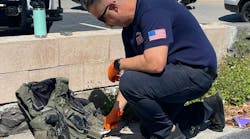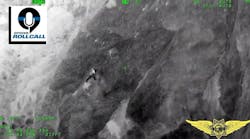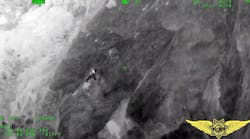The May 22, 2017 suicide bombing just outside the Manchester Arena is once again another horrific reminder that further attacks could occur at and/or around public venues in the United States at some point. Only misguided thinking by some would lead them to think that such attacks and plotting by lone actors or terrorists groups will be confined to Europe. Because the U.S. has not had a directed attack at a public venue, some in law enforcement continue to operate status quo and neglect the venues in their cities with consequential training for their SWAT teams. Furthermore, some in the venue industry have not reached out to their local SWAT team for dialogue, team walk thru’s, and onsite training. The perception of a venue being security hardened could be the difference from being targeted by terrorists or not. What have we learned from the Manchester’s suicidal bomber attack method and timing. Have we begun to disseminate this information and train accordingly for those officers who work the venues or do these venues continue to operate in the same manner in regards to their uniformed presence and staffing levels. This article will examine some of the challenges for the law enforcement and the venue industry and present options for being better prepared to prevent an attack.
The Point of Attack
The main outside ticket counter area of the arena was the ‘X’ (point of attack) for the bomber who had fragmentation contained with his improvised explosive (IE). This bombing may be the first intentional detonation targeting the ingress/egress area of a venue anticipating guests leaving at the end of an event. Whether the terrorist intentionally planned to detonate in this area or not, the fact remains that on the egress from many venues security is typically light and uniformed police officers are directed to areas to move the traffic flow (pedestrian or vehicular). Uniformed police officer and security staffing should not only be increased in the inner perimeter of the venue, but also in adjacent parking lots and multi-level parking garages. These parking areas should be swept by trained law enforcement personnel or trained security prior to and during the event. In addition the use of bomb detection vapor wake dogs can greatly speed up the process as the K9’s are able to cover large areas quickly and provide real time recognition to their handler. During the guests ingress/egress police presence in a marked vehicles in the adjacent parking areas can provide a further visible deterrent.
Reality Based Training (RBT)
Training and education are key for the venue staff, security and law enforcement. Conventional training models are outdated and emphasis should be on the current world threats. IE’s (Improvised Explosives) detection training and immediate action plans should be trained for all that are working the event. A huge asset is the local bomb technicians from the police or sheriff’s department. They can easily set up replica bomb detection corridors in the venue for training and education when no events are scheduled. Allowing police officers and security who serve at the venue to conduct consequential training not only prepares themselves, but fosters an environment of ownership within the venue. In addition police officers that regularly work venues favor Reality Based Training (RBT). Many officers remark that RBT is some of the best, most relevant training they receive in their law enforcement career. Reality Based Training defined is any manner of training that utilizes tools, techniques or methodologies to approximate in a training setting any situation that might occur in an operational setting. Active Shooter, Suicidal Bomber, Hostage Rescue are just a few of potential incidents that could arise inside or outside a venue that can be trained utilizing RBT methods.
Past and Current Security Plan & Costs
The venue industry needs law enforcement assistance with their product. Just as the law enforcement is a necessary evil required in our society to keep peace and prevent chaos, so it is at large gatherings that could be potentially targeted by terrorists. Safety and security is of the utmost priority at any event and unarmed security personnel working the venue does not meet the standard of armed and trained uniformed police officers. Prior to 9/11, law enforcement was viewed as a limited resource needed at venues for disturbances and traffic & crowd control. Soft security did the bulk of the work handling minor disturbances and assisting with the guest’s experience. Security costs could be managed with heavier amounts of security personnel at lower wages in lieu of more police officer at higher hourly wages. The Manchester Arena bombing throws that security paradigm away. The costs of security now and moving forward will be a debated topic for many in the venue industry as the profit margins continue to shrink. More and more dollars will have to be spent prior to and on event day to ensure the venue and the guests are safe.
SWAT Team Involvement
Local SWAT team involvement is necessary and unavoidable. Throughout the United States the deployment of teams is anything but consistent. It runs a spectrum of little use to maximum use for any event. One of the major culprits in SWAT team involvement is costs. Security costs has been one of the main culprits in utilizing SWAT teams on a consistent basis. Who will pay? Does the event organizer foot the bill or is it the cities responsibility. Is it paid as an extra job for the officer or is he paid his overtime rate. Does the city pay and the event reimburse the city? There is no one method that is consistently used. Security costs will continue to skyrocket as terror attacks continue. Also a barrier to SWAT team involvement is the resistance from some venues and their management. Some are reluctant to allow teams in to train due to unfounded fears of damage or inconveniencing the daily schedule of the venue. This is a very narrow and shortsighted view and we can no longer afford to operate in this manner. The 2015 bombing at the Stade de France and the Active Shooter event at the Bataclan theater and now the Manchester Arena continue to underscore that public venues are and will continue to be targeted. These venues are targeted quite possibly due to the minimal security and lack of police presence to fight the attackers. Terrorists conduct pre-target analysis to see where they can have the greatest success with minimal security. That is why local SWAT team’s involvement in areas of training and deployment on event day is critical. The team members become inherently more familiar with the venue other than being a traditional guest at an event. Loading dock areas, lower concourse access and cat walks areas are just some of the areas that team members can familiarize themselves with. Training allows for the development of plans and coordination with venue management and staff. Venue management in conjunction with SWAT Commanders should consider inviting the media out to observe limited training by the SWAT teams. This not only allows the potential guest to see that the venue is being proactive about their safety and security, but it also gets it out there to the lone actor/terrorists that this particular venue may be more trouble than its worth.
Vehicular Attacks at Public Venues
The venue industry is increasingly concerned about terrorist use of vehicles to run over guests that could be on the ingress or egress to an event. Facility design elements such as bollards, fencing, and enclosures must be evaluated and assessed if they are practical for stopping a vehicle of any size from gaining close proximity to the venue. The employment of 50 Caliber rifles by SWAT personnel strategically placed on perimeter observation posts is already occurring at certain venues. These rifles have the required kinetic energy and long range capability needed to stop vehicles of varying sizes if an attempt is made. Also, placing SWAT personnel with long guns at security check points to include delivery areas would increase the capabilities to stop an individual(s) intent to cause harm to guests. The mere showing of SWAT officers at a venue could thwart a planned attack.
Working Together
Moving forward the venue industry and local SWAT teams will have to begin a dialogue to discuss involvement at the venue. The dialogue and subsequent table tops will have to progress to practical training at some point. Venue management is responsible along with the local law enforcement agency for the safety and security of the guests while at their venue. A deliberate shift in thinking is required to ensure that attacks that are occurring overseas do not occur at our U.S. venues. Much can be done on the front end to prevent this, but the dialogue and training must begin now between each.


